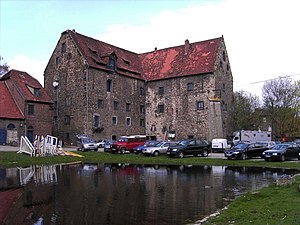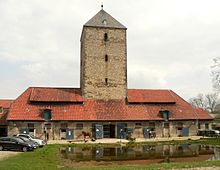Steuerwald Castle
| Steuerwald Castle | ||
|---|---|---|
|
Palas of the Steuerwald Castle in Hildesheim |
||
| Creation time : | 1310-1313 | |
| Castle type : | Niederungsburg | |
| Place: | Hildesheim - Steuerwald | |
| Geographical location | 52 ° 10 '9 " N , 9 ° 55' 39.4" E | |
|
|
||
The Steuerwald Castle is a castle in the Steuerwald district in the north of Hildesheim .
location
The castle is not far from the confluence of the copper strand in the innermost . The facility can be reached from Bundesstraße 6 via Mastbergstraße which branches off to the west. The distance to Hildesheim city center is just under 3 km.
history
Bishop Heinrich II. Von Woldenberg (term of office 1310-1318) had the Steuerwald Castle built as a protective and stronghold against the Hildesheim citizens north of the city from 1310-1313. For the same reason in 1346 south of Hildesheim by one of his successors, Bishop Heinrich III. von Braunschweig-Lüneburg (term of office 1331-1362), founded another castle, the Marienburg . From this time until 1573, the Steuerwald Castle served as a de facto episcopal residence, while the old residence at the cathedral nominally retained this rank. The castle was expanded from 1313–1331 under Bishop Otto II von Woldenberg , creating two ring ditches fed from the innermost part with a wall in between. In 1594 a water mill was built in the castle. A further renovation and expansion took place from 1631 under Bishop Ferdinand of Bavaria .
During the Thirty Years War , Steuerwald Castle was besieged, occupied and recaptured several times. On June 4, 1632, it was taken by storm by Lüneburg troops and severely damaged. The fortifications were then removed. The east and south wings, which no longer exist today, may have been removed on this occasion in order to obtain building material for other buildings on the castle grounds.
Magic trial: In the year 1716, in the presence of a large crowd, one last magician was burned on the local Vehmstätte after being beheaded, who had received his judgment from the episcopal government in Hildesheim.
Bishop Clemens August I of Bavaria had the palace rebuilt in 1728 and the damage caused during the Thirty Years' War repaired. Then he began to build the new episcopal residence at the Domhof in Hildesheim. The Hildesheim bishops resided at Steuerwald Castle until 1573. The following bishops were in personal union Archbishops of Cologne; they rarely stayed in Hildesheim and then in the residence at the cathedral. During the secularization of 1803, the castle was converted into a state domain . It was administered together with its lands by the monastery chamber, an institution of the Prussian state. At the beginning of the 19th century, the inner moat was filled in and the rampart leveled; today's mansion was built in the southern part of the castle after a barn was demolished in 1819. The city of Hildesheim bought the castle and its lands on September 1, 1912 from the monastery chamber in order to obtain land for the construction of a port.
In the Middle Ages, the village of Essem was not far from the castle, in the area of today's Hildesheimer Hafen. After the construction of Steuerwald Castle, it became deserted . A small village called Steuerwald was built around the castle, which had 231 inhabitants at the census in 1895 and was incorporated into Hildesheim in 1912. It was partially demolished before the Hildesheim harbor, inaugurated in 1926, was built.
During the Second World War , a bomb detonated at Steuerwald Castle on October 9, 1943, killing four people. This was the first bombing on Hildesheim. A photo posted in the chapel shows damage to the roofs of the palas, stables and large barn, while the chapel and keep remained intact.
The castle has been used by the Hildesheim riding and driving club since 1973. Due to the various uses of the courtyard, the castle is a bit on the sidelines, as a divided residential building of mediocre state of preservation hardly worthy of a former bishop's residence, although it is one of the few authentically preserved medieval complexes in the region, next to the Marienburg and Steinbrück Castle . The Steuerwaldstiftung was founded in 2001 for the purpose of restoring, maintaining and using the Steuerwald Castle. The roof of the Palas was renovated in 2010.
investment
The castle was built as a moated castle, two parts of the outer ring moat are still preserved in the south and west of the castle. To the west of the mill moat, which branches off from the Innerste with a length of around 250 m, which is still clearly recognizable today, there is an elongated half-timbered house from the second half of the 18th century outside the actual castle complex on a base made of rubble stones. It was used as a storage facility and has not been renovated.
Inside the castle, various buildings are grouped around the courtyard with an area of approximately 175 × 175 m:
The 26 m high keep , which was built in 1325 and served as a gate tower , is visible from afar . Its base is 9.35 × 9.35 m, the thickness of its walls is 2 m. With its barred windows, it has served as a prison several times throughout history. Today the keep is surrounded by an elongated stable built in 1819.
The three-storey palace was initially only of today, built of red sandstone blocks west wing. Bishop Otto II had the building expanded until it consisted of four wings, as can be seen on a copper engraving by Merian . The hall was rebuilt in 1728 under Bishop Clemens August von Bayern. Today only the west and north wings are preserved, the latter was built from rough sandstone blocks. The eaves height of the hall is 15 m, the ridge height is 23.15 m. The west wing is the main wing, the north wing is the secondary wing. The former knight's hall is located on the third floor of the hall , but like the entire building, it is not accessible. What is striking is a bricked-up, ogival late Gothic double window in the west wall of the west wing, which may have belonged to an episcopal chapel. After the secularization, a brewery was housed in the vault of the hall.
A water mill was built in 1594 under Bishop Ernst Duke of Bavaria in the western part of the castle; it burned down in 1905; only very small remains are preserved.
The large barn was built at the same time as the keep, but was expanded and rebuilt several times.
The manor house with its outside staircase was built in 1819 on the demolished quarry stone wall after the castle had been converted into an estate.
The St. Magdalenenkapelle , built in 1310 in the Romanesque style, was built in 1310 in the Romanesque style under the patronage of the Hildesheim Magdalenenstift . In 1507, the Hildesheim bishop Johann IV. Had the chapel redesigned in the Gothic style. In doing so, u. a. the existing windows were enlarged and three more windows were built in the area of the apse . The year 1507 and the coat of arms of the bishop can still be seen above the pointed arch of the entrance portal. The western wall of the chapel is part of the surrounding wall of the castle, of which a well-preserved piece can still be seen north and south of the chapel. After the Second World War, the services of the Michaelis parish, whose church had been destroyed, were held in the St. Magdalenenkapelle. A partial renovation took place in 1990. The chapel has about 55 seats and has been used for weddings, readings and concerts since 2001. It was renovated privately, for which in 2008 the Prize for Monument Preservation of the Lower Saxony Sparkasse Foundation was awarded as recognition and distinction .
Riding and jumping tournaments take place behind the castle; there is also a racecourse for greyhounds .
sightseeing
At the moment, the facility can only be viewed from the outside, as Steuerwald Castle is leased to the Hildesheim riding and driving club and is therefore not accessible to the public. The St. Magdalenenkapelle is also only open on special occasions. There are several hiking trails around the castle that allow a view of the complex. A well-developed cycle path leads from Mastbergstrasse along the Kupferstrang waters to the Hildesheim districts of Moritzberg and Himmelsthür .
literature
- Margret Zimmermann, Hans Kensche: Castles and palaces in Hildesheimer Land . Hildesheim, 2001, pp. 74-77
- Markus C. Blaich , T. Kohnert: Castle Steuerwald. On the castle building of the Hildesheim bishops in the 14th century. In: Hildesheimer Jahrbuch 85 , 2013, pp. 11–50.
Web links
- Entry by Gudrun Pischke on Steuerwald in the scientific database " EBIDAT " of the European Castle Institute
Individual evidence
- ↑ Joachim Lehrmann : For and against the madness - witch hunt in the Hochstift Hildesheim, and "A contender against the witch madness" - Lower Saxony's unknown early enlightenment (Justus Oldekop) . Lehrte 2003, ISBN 978-3-9803642-3-2 , pp. 136-142.







